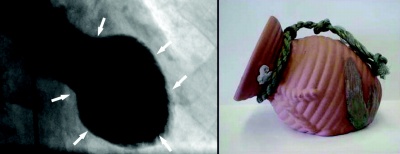Takotsubo Cardiomyopathy
Original Editors - Megan Kaiser & Briana Ulanowski from Bellarmine University's Pathophysiology of Complex Patient Problems project.
Top Contributors - Megan Kaiser, Briana Ulanowski, Kim Jackson, Lucinda hampton, Elaine Lonnemann, Wendy Walker, WikiSysop, 127.0.0.1 and Adam Vallely Farrell
Definition/Description[edit | edit source]
Takotsubo cardiomyopathy occurs when there is an abnormal contraction of the transient left ventricle, creating a balloon shape appearance initially during systole. The Japanese first described the heart condition around 1991. The shape of the heart resembles a Japanese octopus pot with a rounded bottom and narrow neck; hence the name tako-tsubo.
Typically an intense emotional stress can trigger this type of event. High levels of catecholamines are present in these patients and can cause the heart to be stunned temporarily. This is a reversible cardiomyopathy and clinically presents as a myocardial infarction. Individuals that experience this may or may not have a cardiovascular disease.
Other names include:
—Broken heart syndrome
—Ampulla cardiomyopathy
—Stress cardiomyopathy
—Apical ballooning syndrome (ABS)
—Acute left ventricular ballooning
Prevalence[edit | edit source]
add text here
Characteristics/Clinical Presentation[edit | edit source]
add text here
Associated Co-morbidities[edit | edit source]
add text here
Medications[edit | edit source]
add text here
Diagnostic Tests/Lab Tests/Lab Values[edit | edit source]
add text here
Etiology/Causes[edit | edit source]
add text here
Systemic Involvement[edit | edit source]
There are a number of possible complications in patients who present with takotsubo cardiomyopathy. Left-sided congestive heart failure with pulmonary edema, cardiogenic shock, ventricular fibrillation, left ventricular thrombus formation, and left ventricular free wall rupture are all possibilities. Death is included in this list; however, the mortality rate is only 0-8%, and generally less than 2%.[1]
Medical Management (current best evidence)[edit | edit source]
add text here
Physical Therapy Management (current best evidence)[edit | edit source]
add text here
Alternative/Holistic Management (current best evidence)[edit | edit source]
add text here
Differential Diagnosis[edit | edit source]
add text here
Case Reports/ Case Studies[edit | edit source]
Resources
[edit | edit source]
add appropriate resources here
Recent Related Research (from Pubmed)[edit | edit source]
see tutorial on Adding PubMed Feed
Extension:RSS -- Error: Not a valid URL: addfeedhere|charset=UTF-8|short|max=10
References[edit | edit source]
see adding references tutorial.
- ↑ Barker S, Solomon H, Bergin JD. Electrocardiographic ST-segment elevation: Takotsubo cardiomyopathy versus ST-segment elevation myocardial infarction – A case series. Amer J of Emer Med 2009; 27: 220-226.







